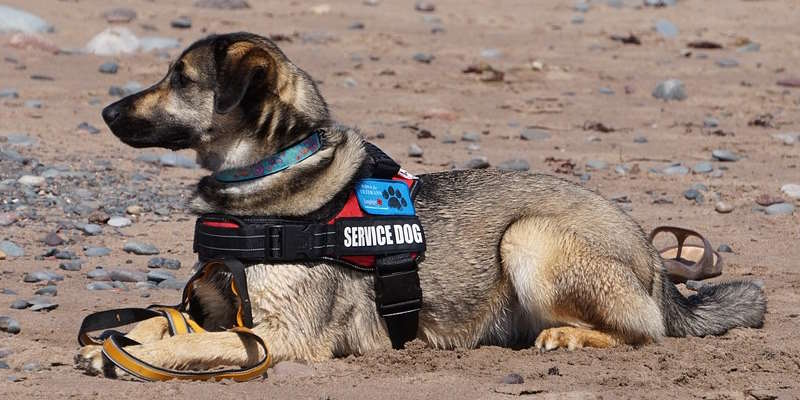Dogs on cruise ships—adorable furry companions or unwelcome four-legged barking mess-makers? This debate splits cruisers down the middle. Pet lovers want pet-friendly areas onboard, while skeptics worry about barking, hygiene, and messes—questioning whether pets belong at sea at all.
So, what’s the reality? Can you bring dogs, cats, or other pets onboard—and if so, under what circumstances? Let’s dive in and explore where your four-legged friends are welcome, the challenges they might face, and why this topic sparks so much debate among cruisers.
Cruise Lines That Allow Pets On Board

Thinking of setting sail with your furry friend? The good news is that dogs and cats can hit the high seas and travel in style. The caveat? Only one cruise line rolls out the red carpet for pets, and places are limited. Let’s look at where dogs and cats are welcome onboard.
Cunard

Cunard’s Queen Mary 2 is the gold standard for pet-friendly cruising. They don’t just tolerate pets—they pamper them. Think air-conditioned kennels, daily visiting hours, and even a welcome pack. But there’s a catch: space is limited to 24 kennels, so you’ll need to book early to avoid disappointment.
What else do you need to know about Cunard’s pet policy? Only relatively small breeds of dogs are allowed—up to 26.7” (68 cm) tall and 58.6” (149 cm) long. Also, certain breeds, including Dobermans, Great Danes, St. Bernards, Greyhounds, and Afghans, cannot travel.

Cunard has even gone the extra mile to make U.S. dogs and U.K. dogs feel at home. Deck 12—the pet deck—has a Liverpool lamp post and New York fire hydrant for those “need-to-lift-the-leg” moments.
Got a pet rabbit, guinea pig, ferret, or gecko? Unfortunately, they’re not welcome as Cunard Cruise Lines only accepts cats and dogs.
Cruise Lines That Allow Service Animals Onboard

Most major cruise lines allow dogs on board if they are registered service animals. These include Royal Caribbean, Norwegian Cruise Line, Celebrity Cruises, and Carnival Cruises. However, you have extra pre-cruise preparation to get your pooch onboard.
After some research, I discovered that policies on cruise lines differ drastically, so check ahead to see if you’ll need to bring dog food, a bed, and where your four-legged friend can relieve itself. You’ll also need to provide documents showing that it’s a legally registered service pet.
But don’t expect full pet-friendly perks—these policies are strictly for trained assistance dogs, not your average pooch. The dog must squeeze into the cabin you’ve booked and cannot be left in the stateroom unattended. What about aggression, excessive barking, initiating unsolicited contact, or growling? It’s a reason for you and your service dog to get kicked off the ship.
What about emotional support dogs? While you love your supporting friend, they don’t make the cut for cruise lines. For example, Royal Caribbean’s website states, “Our policy now differentiates emotional support animals from service animals that are trained to perform a function for a person with a disability. We will no longer have emotional support animals onboard.”
From what I discovered, the major cruise lines have similar policies on emotional support animals.
Margaritaville at Sea (Cruise Tails charter)

Looking for a fully dog-inclusive voyage? The Cruise Tails charter by Margaritaville at Sea is where it’s at. It’s one of the few specialty cruises where four-legged furry friends are just as welcome as their two-legged owners.
Think pet-friendly cabins, onboard play spaces, and even dog-friendly excursions. It’s like a floating dog park—but with cocktails for the humans. But before you go ahead and book a cabin for yourself and ‘Fido,’ there are a few things to know beforehand:
- Limited spaces are available—250—and they are chosen at random
- Doggy bathrooms, or relief stations, are conveniently located on each balcony
- Dogs aren’t allowed in dining rooms or near pool areas
- Numerous activities for pets and their owners are available onboard
- Not all breeds are allowed
- Dogs must always be on a leash
- Vaccinations are a strict requirement
Why Pet Owners Love Cruising With Pets

My pet-owning cruiser friends tell me that leaving furry family members behind feels incomplete. One cruiser mentioned how having their dog onboard felt like taking a piece of home along, sharing that Cunard’s kennel services made the trip stress-free for both owner and pet.
I also came across many online comments about the companionship and emotional support pets provide. A traveler shared that having their pet cat on the transatlantic cruise helped alleviate anxiety and gave huge emotional relief. Another said that visiting their pet while on board was such a treat.
Others rave about the special memories created. On a forum, one dog owner described the special feeling of knowing their pet was getting pampered as much as they were. The pet got freshly cooked chicken, slept in an air conditioned kennel, and enjoyed daily walks.
The Practicalities of Pets on a Cruise Ship

Bringing a pet on a cruise isn’t as simple as packing their leash and treats. Cruise lines have strict policies that can make or break your trip. Ensuring vaccinations are up to date, filling out the correct paperwork, and paying extra fees, cruising with dogs can be challenging.
Cunard’s Queen Mary 2 ocean liner is the only one with dedicated pet facilities. They offer luxurious kennels, potty areas, play spaces, and staff that care for pets. Also, you can visit your pet during designated times.
But most cruise ships aren’t designed with pets in mind, making bathroom breaks or exercise challenging—even on pet-friendly charters. Also, there are no dedicated accommodations for service animals. So, living space can feel cramped, and potty areas may be far from your cabin.
Planning a shore excursion? Keep in mind that service animals can’t be left in staterooms or unattended. First, no dog-sitting services are available. Second, you cannot leave a service animal in the stateroom. Therefore, if you plan an onshore excursion, you must ensure your service pet can enter the port—not all countries are so accommodating for service animals.

Extra costs, tight rules, and limited space mean pet-friendly cruising requires serious planning—and an early booking. Add to that size or breed restrictions, and you’ll see why cruising with pets takes more prep than people often realize.
Why Pets Onboard Cruise Ships Are So Divisive: Criticisms and Concerns
Barking dogs, allergic passengers, messy “accidents,” and more. All reasons why many cruisers want pets off cruise ships faster than a dog shakes off fleas. The debate is far from over, and everyone’s got an opinion. What’s the attitude of cruisers who hate dogs on board? Here’s what I’ve discovered in online forums.
Stress on animals

The biggest concern among cruisers about dogs onboard is stress. Giant cruise ships can be overwhelming for dogs. Think about it: no parks or open spaces to run around in. Instead, strange loud noises, unfamiliar surroundings, and limited space. This environment can leave pets feeling anxious or scared.
Online, some pet lovers express guilt about bringing their furry friends aboard. One cruiser admitted, “I once saw my service dog trembling during a storm. Even though I needed her, I felt helpless, and it broke my heart,”
Others argue that pets shouldn’t face confined spaces for days on end, especially when they can’t fully understand what’s happening. Another said that they are a dog lover and have two dogs, but cruise ships are not for them.
Hygiene and cleanliness issues

The thought of accidents in public spaces makes some passengers uneasy. After all, cruise ships are confined spaces, and hygiene is a big concern. So, adding pets into the mix raises concerns about how messes are managed and whether they disrupt others.
One cruiser wrote, “On my last cruise, I saw a “service dog” taking a leak on the promenade deck. I’m sure the owner snuck their pet past security, claiming it was a service animal.” Another told about passing a cabin attendant cleaning poop in the hallway after a service dog had an accident.
Fur, odors, and worse in shared spaces? For many cruisers, that’s a dealbreaker. A cruiser wrote that they pay hundreds of dollars for “a clean, relaxing vacation, not to dodge poop bags or deal with doggy smells.” Others argue pets shouldn’t be on board at all if staff can’t guarantee spotless conditions. Yes, it’s a messy debate.
Noise and disturbance

Cruisers complain that dog lovers are barking up the wrong ship when advocating pets on board. Imagine if your noisy neighbor was a non-stop barking dog. A nightmare for most cruisers. Although service animals are highly trained, the threat of constant whining, barking, or growling worries cruisers.
Legitimate complaints about barking dogs on cruise ships seem to be about dog owners who fake their pet’s “service” status. Cruisers also complain that, even on the Queen Mary 2, which has a dedicated dog area, barking is an issue. Some passengers vent their fury about howling and barking from Deck 12 when dogs are left in kennels during opening times, and their owners can’t be bothered to visit them.
Another cruiser commented that the “service dog” in the neighboring balcony constantly barked at their service dog. It seems that the neighbors had passed off an untrained pet as a service animal.
Safety and behavior

Unfortunately, even the friendliest and best-trained dogs have bad days. And that worries many cruisers. Even service dogs can display unpredictable behavior. Some passengers recount incidents of poorly trained pets causing problems. A traveler recalled how a dog on a leash seemed to lunge at them on the gangway.
Although the incident didn’t happen on a cruise ship, I read reports about a service dog biting two people at Denver International Airport. So, concerns about snapping and biting are not far-fetched. For many, this unpredictability is a valid reason to be wary of all animals—regardless of training—onboard.
Regulatory and logistical challenges

Traveling with pets isn’t easy, and cruise ships add extra layers of complexity. You must sort out vaccination records and health certificates. Also, when you’re in port, you must follow country-specific rules. One frustrated cruiser with a service dog commented on how stressful it is trying to keep up with every port’s requirements and check all vaccinations.
Others share logistical woes like finding suitable potty areas or dealing with motion sickness. Let’s face it—even though service dogs are allowed, cruise ships are not built for them. Consider that there are no exercise areas, the potty zone might be far away, and you’ll have even less room in a cabin.
These hurdles leave many wondering if cruising is worth the effort for service pets.
Allergies and phobias

For some worried cruisers, pets onboard aren’t just an inconvenience—they’re a health risk. Allergies to pet dander, including dogs, are real. Doctors say that dog allergies in humans can cause sneezing, itching, hives, or even asthma attacks in sensitive individuals.
Of course, even though you’re not supposed to pet service dogs, cruisers with strong allergies are rightly concerned. After all, dander gets everywhere. It can lay around for a long time on surfaces, chairs, and floors.
Fear of being bitten or attacked

I get it—the risk of a service animal biting someone is minimal. But that doesn’t help some people be close to dogs due to cynophobia. What? The overwhelming fear of dogs. Doctors from the Cleveland Clinic say that even hearing a dog bark could trigger severe anxiety or a panic attack.
A cruiser commented about their fear of dogs and that seeing one unexpectedly on a cruise would ruin the vacation. “I know they’re on a leash and won’t lunge at me, but still, I’m scared of dogs,” lamented one passenger.
Seasickness rocks the boat for pets

Cruising isn’t always smooth sailing, and seasickness can hit dogs hard. Even well-trained service dogs aren’t immune to seasickness—cue the drooling, whining, and nausea. And who wants to watch a poor dog wrenching or vomiting in the buffet because of motion sickness?
One seasoned cruiser commented that handling their own seasickness was hard enough, but it became overwhelming when their service dog got seasick. Seasickness highlights a significant concern: Are cruises truly comfortable for animals?
You can treat seasickness in dogs or cats by giving them Dimenhydrinate or Maropitant.
Impact on Non-Dog Lovers

Let’s face it—not everyone loves four-legged fur balls. For non-dog lovers, the idea of pets onboard feels intrusive, especially in shared spaces like dining areas or pool decks. One cruiser shared online their feelings about dogs, “I don’t hate them, but I don’t want to share my vacation with them.”
I’ve heard that even with service animals, there’s a sense of unease. One fellow cruiser told me that they understand they’re necessary, but they feel uncomfortable having a dog near food.
Part of the tension stems from how cruise lines manage service animals. Many only accommodate them because the law requires it, so cruise lines only offer minimal facilities.
Alternatives for Pet-Loving Travelers

Options to cruise with pets are slim. Aside from Cunard’s Queen Mary 2, specialty charters, or service animals, your four-legged friend’s paws are staying on terra firma. But if having animals involved in your vacation adventures is a must, here are some unique alternatives:
Alaska cruises with Princess

Princess Cruises’ Alaska sailings feature husky sled dogs onboard! OK, not your pet, but an authentic touch of Alaskan charm you can pet onboard.
Celebrity Cruise’s famous cat

Want a pet-friendly vibe without the responsibility? On Celebrity’s Edge Class ships, you might spot Bug Naked, Captain Kate McCue’s hairless sphynx. Bug strolls the decks in her own uniform, proving pets can be part of the cruise life in unexpected ways.
Hit the road

For ultimate pet comfort, consider a driving trip that combines short, pet-friendly cruises. Road trips let you bring your pet along and enjoy some time at sea, sailing on lakes, or cruising rivers. Plus, you can plan stops, explore dog-friendly destinations, and control your pet’s environment every step of the way.
Here are four ideas shared by cruisers who’ve combined road trips and cruises:
- European island hopping: Fly to Europe, hire a car, and hop on pet-friendly ferries to explore islands. Destinations like Greece or Scandinavia offer plenty of options.
- California coastal cruising: Drive down the California coast in your car or RV and enjoy dog-friendly harbor cruises in San Diego or Santa Barbara.
- Great Lakes road and cruise combo: Drive to Michigan and the picturesque Great Lakes region, then hop on a dog-friendly ferry to explore islands like Mackinac or other scenic spots.
- Houseboat rentals: Rent a dog-friendly houseboat on one of the Great Lakes, Mississippi River, or other similar destinations in the U.S. for a cozy, water-bound getaway. Your pet will love the freedom to explore with you.
My Thoughts as a Non-Pet Owner About Animals Onboard Cruise Ships
I don’t have anything against pets—they’re wonderful companions for many. Many of my friends have them, and they’re great to interact with. Also, I realize the need for service animals onboard—after all, everyone should be able to enjoy the cruise experience. Unfortunately, cruise lines don’t do enough for people with disabilities.
That said, I wouldn’t book a cruise knowing pets were allowed as a general policy. For me, a cruise is about relaxation, not worrying about barking, fur, or potential accidents in shared spaces. While I get why others love it, a cruise with pets onboard doesn’t quite fit my idea of a peaceful getaway.
Related articles:

